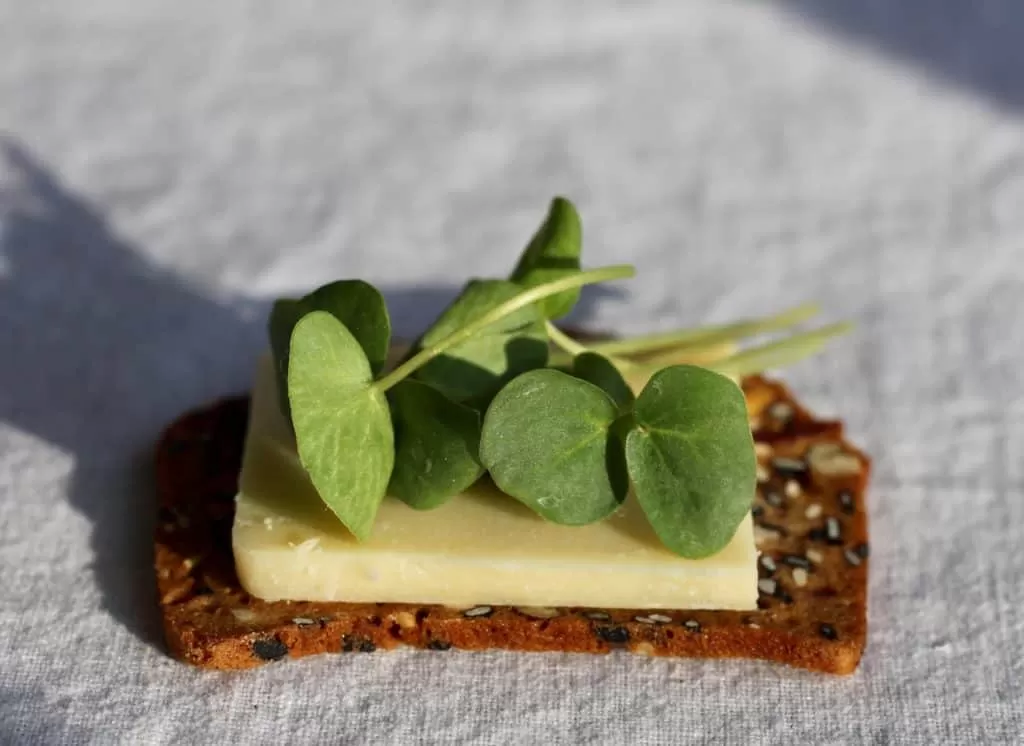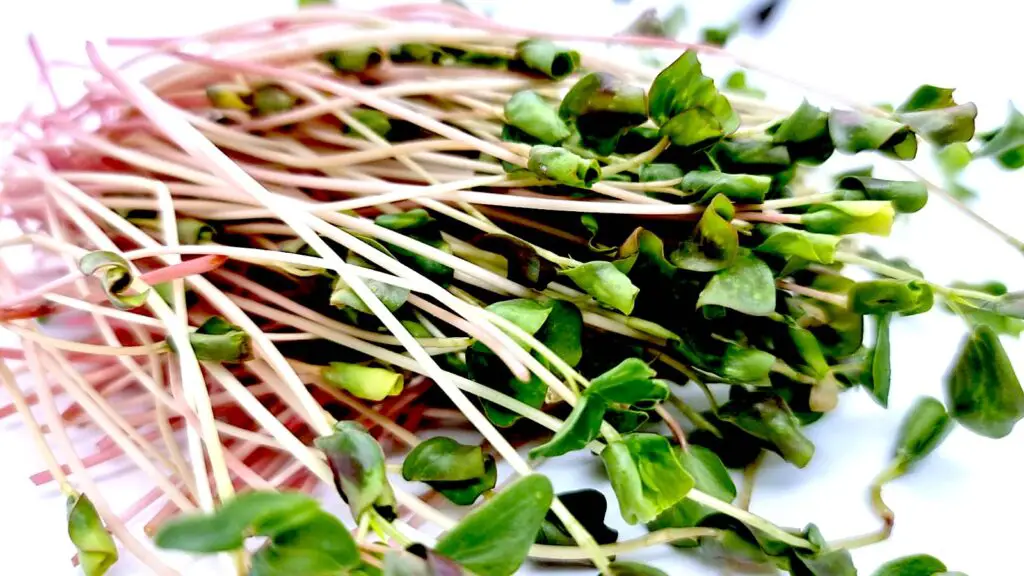If you’re looking for a way to add more nutrition and flavor to your diet, buckwheat microgreens are an excellent choice. This nutrient-dense superfood is packed with vitamins, minerals, and antioxidants, making it a great addition to any meal.
In this article, we’ll explore the health benefits of buckwheat microgreens, how to grow them at home, and how to incorporate them into your meals.

Contents
What are buckwheat microgreens?
Are you looking for an easy and convenient way to get your daily dose of vitamins and minerals? Consider introducing buckwheat microgreens into your diet. Buckwheat is a type of cereal grain that is full of vitamins, minerals, amino acids, and other beneficial compounds.
It’s also a powerhouse of antioxidants, dietary fiber, phytonutrients, and minerals like magnesium, calcium, and iron.
It is consumed in Asian countries for centuries and is now becoming increasingly popular due to its many health benefits.
These microgreens are harvested as soon as the seedlings start to sprout, just two weeks after being planted. They are small in size but packed with nutrition. Buckwheat microgreens contain up to 40 times more nutrients than mature buckwheat greens, making them an excellent choice for boosting your health in a variety of ways.
What’s more, you don’t need to grow buckwheat microgreens yourself! You can buy ready-made buckwheat microgreens that are perfect for adding to salads or sprinkling on your favorite dishes. They make a great addition to smoothies too! So why not give them a try – make the most out of their high-nutrient content with little effort!
Health benefits of eating buckwheat microgreens
You may have heard of microgreens — little shoots of fully grown greens that have gained popularity in recent years, but have you heard of buckwheat microgreens? This unique variety contains more nutrients and minerals than the buckwheat grain itself.
Packed with vitamins A, B, C, and E, as well as other essential minerals like manganese, zinc, and potentially powerful anti-inflammatory properties, these tiny nutrient-dense greens are a great way to boost your diet.
The fact that they are gluten-free makes them a good option for most people with allergies. this is a great food for people dealing with allergies (except buckwheat allergy). Aids in lowering levels of LDL cholesterol in the blood. Eating buckwheat also helps to slow down glucose absorption, which is great for diabetic individuals.
Here’s why:
- They are high in protein. Buckwheat microgreens contain more protein than common vegetables like carrots, spinach, or tomatoes.
- They are low in calories. Buckwheat microgreens have a very low-calorie count, making them perfect for dieters who are looking to maintain their weight while still getting the nutrition they need.
- They are rich in minerals. Buckwheat microgreens contain high levels of magnesium, potassium, calcium, and iron. These minerals can help with many health benefits including cardiovascular health and bone strength.
- They promote digestive health. The high fiber content in buckwheat microgreens helps promote digestion and maintain healthy gut flora.
Overall, these tasty additions to your diet can help you meet your daily nutritional needs without sacrificing flavor or texture!
How to eat buckwheat microgreens?
You may be wondering how to include buckwheat microgreens in your diet.
Well, thankfully it’s incredibly easy! There are several ways to incorporate these superfoods into your meal plan.
- Salads
Buckwheat microgreens are the perfect addition to any salad. Their crunchy texture and mini size give salads a great pop of flavor and texture.
All you have to do is add a few tablespoons of microgreens – or even just sprinkle them as a garnish – and you’ve got yourself a deliciously healthy salad!
- Smoothies
These tiny greens make for an ideal smoothing ingredient. Add them to any smoothie for an added boost of vitamins and minerals – it’s like a green smoothie, but with a unique nutty flavor from the buckwheat!
- Sandwiches
If you’re looking for something more savory than sweet, try adding buckwheat microgreens to sandwiches. They’re the perfect accompaniment for all sorts of meats, cheeses, and fresh vegetables, like tomatoes or cucumbers. The possibilities are endless!
You can also sprinkle buckwheat microgreens on top of grilled chicken or fish dishes, stir them into soups or casseroles, or use them as an ingredient in homemade pestos, hummus, and dressings. In general, they are easy to include in almost any meal. It is so convenient!

How to grow buckwheat microgreens?
Growing buckwheat microgreens at home is easy and economical.
All you need is:
- Buckwheat seeds
- Soil or growing medium
- Containers with drainage holes
- Water
The steps to growing buckwheat microgreens:
- Make sure that the seeds were soaked in cold water for 12-24 hours before planting, and that the seeds are all rinsed well.
- Begin by seeding your trays with the buckwheat seeds and make sure to spread them evenly across the growing tray. Rather than garden soil, microgreens are best grown in potting soil, since it is ideal for sprouting seeds. Make sure your growing tray has drainage holes.
- Cover the seeds with soil, lightly pressing for good seed-to-soil contact.
- Water the growing tray daily, keeping the soil damp.
- Place the trays in a spot that gets plenty of sunlight, or supplement with grow lights if needed.
- Within five to seven days, you’ll have a growing tray full of ready-to-harvest buckwheat microgreens!
- Cut the microgreens just above the soil line, taking care to leave some of your crops behind for another harvest soon after!
What’s brilliant about this process is that you can repeat these steps and harvest more crops each time until it’s time to start new batches of buckwheat microgreens again!
Enjoy your fresh greens as part of salads, sandwiches, and smoothies — or any other way you like — and feel great knowing that what you are eating is healthy and natural!
Best methods for growing microgreens
If you’ve decided to add buckwheat microgreens to your diet, you may be wondering how best to go about growing and harvesting them. Depending on the climate you live in, there are a few different techniques for getting the most out of your buckwheat microgreen harvest.
- Start with quality seeds
When it comes to growing anything successfully, the quality of your seeds is essential. Look for organic, non-hybrid buckwheat seeds before you get started with your buckwheat microgreens.
- Choose your growing medium
Typically, growers use potting soil or soilless mediums such as coconut fiber or rock wool to grow buckwheat microgreens. But if you feel like experimenting, you can also try using hydroponics. Whichever medium you choose, make sure that it is light and breathable so that your buckwheat plants can get enough oxygen during the growth process.
- Timing is everything
You’ll want to plant your buckwheat microgreen seeds about two weeks before you plan on harvesting them. Your microgreens should be ready after about 5-7 days ― just keep an eye on them and harvest them when they reach a height of 1-2 inches tall.
Make sure not to over-harvest as well ― if you take too many leaves off at once, the plant won’t grow back until it’s been given enough time to replace its lost nutrients from the soil.
By following these simple tips for growing and harvesting buckwheat microgreens, you can ensure that they stay fresh and nutrient-rich all summer long!
How to store buckwheat microgreens?
Like most microgreens, buckwheat has a short shelf life. Knowing how to store microgreens is essential for anyone who wants to enjoy the full benefits of this superfood.
However, these delicate greens are highly perishable and must be stored properly to retain their nutritional value.
- Start by harvesting the buckwheat microgreens when they are still young and tender. Make sure to cut them close to the soil surface, leaving only a few inches of stem.
- Rinse the microgreens in cold water to remove any dirt or debris.
- Place the microgreens in a single layer on a paper towel-lined tray.
- Cover the tray with another layer of paper towels and place it in the refrigerator.
- Change out the paper towels every two days to keep the microgreens fresh.
- Store the microgreens in the refrigerator for up to one week.
Proper storage helps to prevent spoilage and maintain freshness.
It also helps to extend the shelf life of the microgreens, allowing you to enjoy them for longer periods.

FAQ
What does buckwheat microgreens taste like?
Buckwheat microgreens taste mild and nutty that are similar to other grains like quinoa and amaranth. They are slightly sweet with a hint of tangy flavor.
What is the nutritional value of buckwheat microgreens?
So are buckwheat microgreens good for your health? Buckwheat microgreen is rich in vitamins B, vitamin C, and many important micronutrients. The buckwheat microgreen is a healthy diet that increases immunity.
Buckwheat seeds potentially have an anti-inflammatory effect and lower the risk of cardiovascular diseases. Plus, they’re gluten-free products, so most people with allergies can eat them, of course, except for ones with buckwheat allergies.
What is the healthiest microgreen?
Peas have the health benefits of a whole lot of benefits so we often include these organic seeds in our seasonally growing microgreen club. Pea seeds contain beta-carotene, which is the building block of the human body and a vital component.
Conclusion
In short, adding buckwheat microgreens to your diet is a great way to get a boost of healthy nutrients.
They are low in calories yet packed with essential vitamins, like vitamin c and minerals, and the distinctively nutty flavor makes them the perfect addition to salads, sandwiches, smoothies, and more. Plus, they are gluten-free and easy to grow and can be harvested in just a few days.
With their potential health benefits, buckwheat microgreens are a delicious and nutritious way to add a healthy boost to your diet. So why not give them a try?
Read More: How to grow buckwheat microgreens



